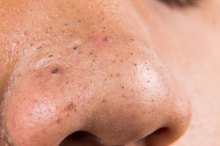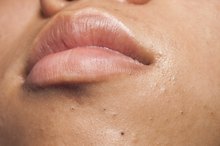What does fact checked mean?
At Healthfully, we strive to deliver objective content that is accurate and up-to-date. Our team periodically reviews articles in order to ensure content quality. The sources cited below consist of evidence from peer-reviewed journals, prominent medical organizations, academic associations, and government data.
The information contained on this site is for informational purposes only, and should not be used as a substitute for the advice of a professional health care provider. Please check with the appropriate physician regarding health questions and concerns. Although we strive to deliver accurate and up-to-date information, no guarantee to that effect is made.
How to Extract Clogged Pores
The skin on your face consists of thousands of tiny pores that feature a hair follicle and a gland that produces sebum--an oily substance that works to keep your skin soft and moisturized. However, hormones can stimulate the gland to produce excess sebum, resulting in clogged pores. Dead skin cells and bacteria also can clog the pores. This can cause pimples, blackheads or whiteheads to form. Because these blemishes can take time to clear on their own, you may wish to extract the materials from the blemish. Special care must be taken when extracting because acne scarring can result when the skin's layers are damaged.
Wash your face with warm water and a gentle cleanser. Wash your hands as well. This allows you to begin with a clean surface so oils, makeup or dead skin cells cannot enter the pores once they are unclogged.
How to Remove Blackheads on the Nose
Learn More
Wet two washcloths and place them in your microwave to warm them. This may take anywhere from 30 seconds to a minute, depending upon your desired heat level.
Take the damp washcloths and place on your face for three minutes. This will help to open the pores, making the materials that clog the pores easier to remove. If you prefer to steam the face, you can heat a bowl of hot water and place a towel over your head in order to open the pores.
How to Get Rid of Blackheads on Your Breasts
Learn More
Take cotton squares or cotton balls and dip them in a mixture of one teaspoon of baking soda and distilled water. Place these cotton squares on any areas where the pores are clogged and leave on for 10 minutes.
Dip toilet paper or cotton squares in a mild astringent, then wrap around your fingers. This helps prevent oils on your fingers from entering your pores.
Place your fingers on either side of the pore and press down gently on either side. If the pore does not automatically come out, try two additional positions for extraction.
Dab a mud mask or facial mask to the affected area after extracting. This will help to dry out the pore and help to remove bacteria, according to DERMA Doctor.
Tips
In order to facilitate the extraction process, you can purchase an extraction tool at a local drugstore or discount super store. The tool comes with a lancet on one side that helps to open the pore and a round-edged end that has a hole where the sebum can come through. Incorporating an exfoliating facial scrub into your daily routine can help to reduce the particles that can clog pores, thus preventing blemishes from forming.
Warnings
If the clogged portions of the pore do not easily come out after a few tries at pressing on the pore, cease your extraction efforts in order to prevent scarring.
Related Articles
References
- Acne: Tips for managing. (n.d.).
- Acne: What is it? (2019).
- Mayo Clinic Staff. (2018). Acne.
- Wang S. Understudied skin characteristics awaiting genetic breakthroughs. J Investig Dermatol Symp Proc. 2018;19(2):S101-S102. doi:10.1016/j.jisp.2018.10.005
- American Academy of Dermatology Association. What can treat large pores?
- Draelos ZD. Cosmeceuticals for male skin. Dermatologic Clinics. 2018;36(1):17-20
- Milam EC, Rieder EA. An approach to cosmeceuticals. Journal of Drugs in Dermatology. 2016;15(4):452-6.
- Sakuma TH, Maibach HI. Oily skin: an overview. Skin Pharmacology and Physiology. 2012;25(5):227-35.
- Yeh L, Bonati LM, Silverberg NB. Topical retinoids for acne. Seminars in Cutaneous Medicine and Surgery. 2016;35(2):50-6.
- Zaenglein AL, Pathy AL, Schlosser BJ, et al. Guidelines of care for the management of acne vulgaris. Journal of the American Academy of Dermatology. 2016;74(5):945-73.
Writer Bio
Rachel Nall began writing in 2003. She is a former managing editor for custom health publications, including physician journals. She has written for The Associated Press and "Jezebel," "Charleston," "Chatter" and "Reach" magazines. Nall is currently pursuing her Bachelor of Science in Nursing at the University of Tennessee.








